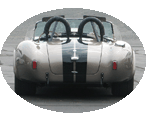 
 Main Menu
Main Menu
|
 Nevada Classics
Nevada Classics
|
 Advertise at CC
Advertise at CC
|
 February 2025
February 2025
|
| S |
M |
T |
W |
T |
F |
S |
| |
|
|
|
|
|
1 |
| 2 |
3 |
4 |
5 |
6 |
7 |
8 |
| 9 |
10 |
11 |
12 |
13 |
14 |
15 |
| 16 |
17 |
18 |
19 |
20 |
21 |
22 |
| 23 |
24 |
25 |
26 |
27 |
28 |
|
|
 CC Advertisers
CC Advertisers
|
|

08-09-2008, 10:26 AM
|
|
CC Member

|
|
|
Join Date: Jun 2005
Location: Toronto, Canada,
On
Cobra Make, Engine:
Posts: 14
|
|

 Not Ranked
Not Ranked
 fuel pressure
fuel pressure
I just installed a Holley Liquid Fuel Pressure gage at the end of the fuel log after the second carb. Only getting (reading) 2lbs. Having a hard time getting the engine to idle. Using a Holley mechanical pump. Is this too low and is it time I installed an electric pump?
427SO, dual holley 1850 (600cfm ea, vac sec.).
|
-
Advertising


08-09-2008, 11:02 AM
|
 |
Half-Ass Member

|
|
|
Join Date: Jun 2005
Cobra Make, Engine: ERA #732, 428FE (447 CID), TKO600, Solid Flat Tappet Cam, Tons of Aluminum
Posts: 22,017
|
|

 Not Ranked
Not Ranked
Quote:
Originally Posted by For Paw

I just installed a Holley Liquid Fuel Pressure gage at the end of the fuel log after the second carb. Only getting (reading) 2lbs. Having a hard time getting the engine to idle. Using a Holley mechanical pump. Is this too low and is it time I installed an electric pump?
427SO, dual holley 1850 (600cfm ea, vac sec.).
|
You can not rely on the readings of a liquid filled fuel pressure gauge under the hood until you learn how it reacts to the heat changes. Check your pressure when the car first starts after it has been sitting over night, then compare that to what it reads after you've been driving it a while, you'll learn how the heat affects the pressure inside the gauge and gives you false readings. Then you'll learn how to spot changes in your pressure, but only because you've learned how your gauge works with your engine and the ambient temperatures, not because you can rely on the readings themselves. |

08-09-2008, 01:33 PM
|
 |
Senior Club Cobra Member

|
|
|
Join Date: Dec 2001
Location: Glendale,
AZ.
Cobra Make, Engine: Cobray-C3, The 60's body lines on todays chassis technology
Posts: 2,302
|
|

 Not Ranked
Not Ranked

Want to shed a little more light on your 2 PSI readings at the current location/conditions. First to get a system pressure you need to deadhead the output of the pump (if any of the 4 needle/seats on dual carbs is open the reading is not correct). The pressure output reading of the pump must be checked with all seats closed, but engine must be running for mechanical pump to work. The carbs fuel bowls hold enough fuel to idle long enough to get a pressure check so not that tough to do.
While being careful of spilled fuel ... yada yada. Place short hose with gauge on the output of mechanical pump and start the engine running on fuel in the carb bowls. The pump has internals to keep it from blowing up, it will only deliver so much pressure and that is what you are checking.
Flow or volume potential is another issue. A pump can deliver the correct pressure but not deliver the proper volume. The method to check volume is to run pump for a fixed time and measure the output volume in given time frame. Look in an older Motor Manual to get spec's on say a 1966 with your cubic inch engine and set up. I know you are not working on a chebbie but easy to find for say Z/28 with multiple carbs and Cubes are close.
Now as far as gauge accuracy and temp I think a quality gauge will get you within <5%+/- of sweep = http://www.autometer.com/download_instruction/425f.pdf after equalized to your area and ave temp. |

08-09-2008, 01:50 PM
|
 |
Senior Club Cobra Member

|
|
|
Join Date: Dec 2001
Location: Glendale,
AZ.
Cobra Make, Engine: Cobray-C3, The 60's body lines on todays chassis technology
Posts: 2,302
|
|

 Not Ranked
Not Ranked
|

08-09-2008, 01:51 PM
|
|
CC Member

|
|
|
Join Date: Jun 2005
Location: Toronto, Canada,
On
Cobra Make, Engine:
Posts: 14
|
|

 Not Ranked
Not Ranked

Thanks guys. I started after it cooled down and pressure was at 5-6.
So after a year of this, I have replaced Carbs from the 390 's it came with to 600-both vac secondaries, I replaced the Carter pump with a Holley I have replaced the Alt with a MSD and now a Reactor. I have advanced the initial to 18 just to get it to idle somewhat properly. There is something fundamentally wrong with this set up. It starts like any stroked FE-with a little persuasion. Once it reaches 60C, it settles down and idles fine at 1000. When it gets to operating temp range. things go funny. It's like it is not getting enough fuel, so just the slightest increase in throttle and it responds instantly. But it can just as quickly die if I don't throttle it. Now I know that you are not supposed to let this engine idle for too long for fear of wiping the cam, but after changing carbs, alternators, fuel pumps, timing, recurving the dist. you would think idle would be Ok. But it just likes to slowly die unless it gets a rev or two. Maybe this is the FE beast. Not sure where to go from here-but I still think this is carb related. Timing is so far advanced that it's getting hard to start when hot. THe electrical checks out fine on the meters. Fuel pressure seems to be OK. I have carb spacers to eliminate on boiling. It's just does not seem to be getting enough fuel/air it the idle circuit.
i am stumped. Anyone want to take a stab.

|

08-09-2008, 02:44 PM
|
 |
Senior Club Cobra Member

|
|
|
Join Date: Dec 2001
Location: Glendale,
AZ.
Cobra Make, Engine: Cobray-C3, The 60's body lines on todays chassis technology
Posts: 2,302
|
|

 Not Ranked
Not Ranked
Bet ya quarter it is just the opposite and runs FAT when at hot idle with dual carbs. Check flaot levels, what carbs are ya running?
|

08-09-2008, 03:35 PM
|
|
CC Member

|
|
|
Join Date: Jun 2005
Location: Toronto, Canada,
On
Cobra Make, Engine:
Posts: 14
|
|

 Not Ranked
Not Ranked
 fuel pressure
fuel pressure
running 1850's 600cfm (4160's). Floats are set so fuel just dribbles out sight holes. Secondaries butterflies just cracked open 1 turn, 0.20" showing on both primary t-slots.
|

08-09-2008, 09:46 PM
|
|
CC Member

|
|
|
Join Date: Jun 2002
Location: Omaha,
NE
Cobra Make, Engine: ERA, 496 Tunnel Wedge
Posts: 132
|
|

 Not Ranked
Not Ranked

Quote:
Originally Posted by patrickt

You can not rely on the readings of a liquid filled fuel pressure gauge under the hood until you learn how it reacts to the heat changes. Check your pressure when the car first starts after it has been sitting over night, then compare that to what it reads after you've been driving it a while, you'll learn how the heat affects the pressure inside the gauge and gives you false readings. Then you'll learn how to spot changes in your pressure, but only because you've learned how your gauge works with your engine and the ambient temperatures, not because you can rely on the readings themselves.
|
Listen to this man.
Dont let the gauge lead you down a rabbit hole, get an old shaky needle gauge, or a mechanics master gauge, before you believe that your car is losing fuel pressure
Most liquid filled gauges, due to relying on pressure differentail, read wrong when exposed to heat. The liquid expands and makes the gauge read low, often zero
As far as the carbs, I have continually fought with modern Holley HP and Avenger series which have the IFR (Idle fuel restrictors) high on the vertical idle well, above the float level. Old Holleys had IFRs in a seperate channel lower, below the float level. Not sure which 600's you are using, but if the IFRs are high, I'd change them in a heartbeat
I have even gone as far as changing my HP metering blocks on my own 1000 HP series to a pair off of 2 1970's 1850s (After drilling the IFR and PCVR to the proper size)
In any case, the issue was similar, any time the motor got real warm it was like the idle and transition circuit lost its mind. I tried it all to cool things down, but it seems to be more with the design
Since the change, no issues
Additional information here:
http://www.innovatemotorsports.com/f...ion+idle+lower
In the picture below, measure, then drill out the IFR at location #6 and put a bushing in #25 and drill to the original IFR size (from the metering block picture)

__________________
1994 ERA Cobra, 496 Genesis FE TW (new addition to the stable)
70 Mustang Fastback, EFI 489 FE TKO-600, too much to list
71 F-100 4x4 EFI 461 FE restomod
Bullock's Power Service, LLC
Concours and performance engines by appointment only
https://www.facebook.com/BullocksPowerService
Last edited by My427stang; 08-09-2008 at 10:25 PM..
|

08-10-2008, 06:30 AM
|
|
CC Member

|
|
|
Join Date: Jun 2005
Location: Toronto, Canada,
On
Cobra Make, Engine:
Posts: 14
|
|

 Not Ranked
Not Ranked
 Fuel Pressure
Fuel Pressure
Thanks for this info-I have tried just about everything else, I will give this one some thought.
|

08-10-2008, 08:25 AM
|
 |
Half-Ass Member

|
|
|
Join Date: Jun 2005
Cobra Make, Engine: ERA #732, 428FE (447 CID), TKO600, Solid Flat Tappet Cam, Tons of Aluminum
Posts: 22,017
|
|

 Not Ranked
Not Ranked
Quote:
Originally Posted by My427stang

Listen to this man.
Dont let the gauge lead you down a rabbit hole...
|
Let me beat this horse one more time just for the benefit of anyone that doesn't believe that you can't rely on the readings of a liquid-filled under-the-hood fuel pressure gauge. Here's a shot of my FE, iding at 870RPM as per the inductive tach, and the fuel pressure is showing just over 3lbs. -- but this is with the engine HOT. I know for a fact that my pressure is a healthy six pounds, and the fuel pressure gauge will read that when it is equalized. FWIW, my manifold vaccum is coming in about 13 inches, and that's what I use to tune my carb.
 |

08-10-2008, 08:46 AM
|
 |
Half-Ass Member

|
|
|
Join Date: Jun 2005
Cobra Make, Engine: ERA #732, 428FE (447 CID), TKO600, Solid Flat Tappet Cam, Tons of Aluminum
Posts: 22,017
|
|

 Not Ranked
Not Ranked
 ... and with the engine cold
... and with the engine cold
As luck would have it, I happened to have a shot when the engine was cold. Note the difference.
 |
 Posting Rules
Posting Rules
|
You may not post new threads
You may not post replies
You may not post attachments
You may not edit your posts
HTML code is Off
|
|
|
All times are GMT -7. The time now is 09:58 AM.
|























 Linear Mode
Linear Mode



